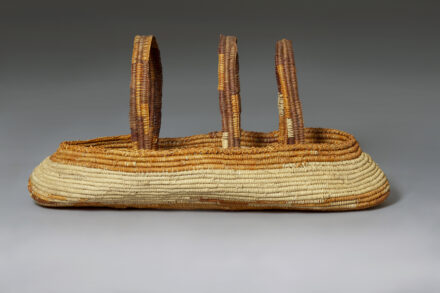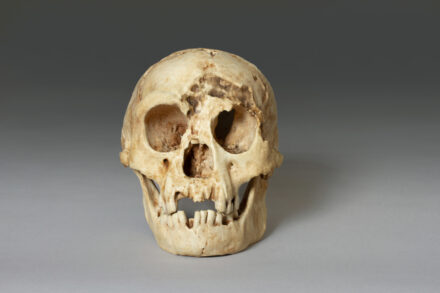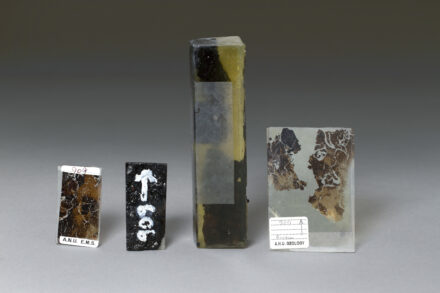
Article by Dr Katharine Balolia
Lecturer in Biological Anthropology,
School of Archaeology and Anthropology, ANU
This specimen, known as Sts 71, is a cast of a cranial specimen that belongs to Australopithecus africanus, an extinct species on the human family tree that is known from around 3 – 2 million years ago (Herries et al. 2013; Pickering & Herries 2020).
Sts 71 was found at a cave site known as Sterkfontein, located around 40 km from Johannesburg, South Africa. The fossil discovery was made by Robert Broom and John Robinson in 1947 and was later described by the discoverers (Broom & Robinson 1950; Robinson 1956). The layer in which the specimen was found (Sterkfontein Member 4) has recently been dated to 2.61 – 2.07 million years ago using Uranium-Lead dating, in conjunction with palaeomagnetic sequencing (Pickering & Herries 2020). This means that the population from which this specimen belonged overlapped with the earliest members of our own genus, Homo, who is first known from 2.8 million years ago from Ethiopia (Villmoare et al. 2015).
The gracile australopithecines (genus: Australopithecus) are widely recognised as the first members of the family tree to habitually walk on two legs, though features of their arm bones and hands indicate that they still retained features associated with a tree-dwelling lifestyle (McHenry 1986). Their brain size is similar to that of living apes (e.g. chimpanzees and bonobos), and was smaller than that observed in later Homo species, such as Homo ergaster or Homo erectus (Neubauer et al. 2012). Therefore, Australopithecus africanus can be viewed as a relatively primitive member of the human family tree. It is unclear whether Australopithecus africanus was a direct ancestor of Homo sapiens, though the specimen shows substantial morphological similarities to Homo habilis, who is one of the earliest known species of the genus Homo. Sts 71 was an adult, as indicated by its wisdom teeth being fully erupted (Lockwood 1999). The sex of this specimen is still debated. Broom and Robinson (1950) initially thought this cranium belonged to a female based on the small size of the skull. While most researchers agree, consensus has not yet been reached about whether Sts 71 was male or female, in part due to its slightly prominent glabella morphology (region between the eyebrows), a feature that is often associated with males (Lockwood 1999). The discrepancy between the small size of specimen and the prominent supraorbital morphology (region above the eyes) is characteristic of the unique pattern of morphological variation observed in Australopithecus africanus. This unique pattern of variation means that we cannot confidently assign a sex to this specimen.
The Sts 71 cast specimen held as part of the ANU Biological Anthropology Collection has been 3D surface scanned using a NextEngine scanner, as showcased in the 3D rotating specimen above. 3D scanning has many applications, including scientific research, education and outreach. 3D models are particularly useful to conduct research on fragile fossilised remains. This is because once the specimen has been 3D scanned, researchers can take measurements from the 3D model instead of from the original specimen itself. This reduces the risk of the original specimen being damaged, and 3D scanning the object further serves to digitally preserve the specimen.
The original fossil specimen of Sts 71 is held at the Ditsong Museum, Pretoria, South Africa.
References
Broom, R & Robinson, JT 1950, ‘Further evidence of the structure of the Sterkfontein ape-man Plesianthropus’, Transvaal Museum Memoir, vol. 4, pp. 7–83.
Herries, AI, Pickering, R, Winfield Adams, J, Curnoe, D, Warr, G, Latham, AG & Shaw, J 2013, ‘A Multi-Disciplinary Perspective on the Age of Australopithecus in Southern Africa’, in K Reed, J Fleagle & R Leakey (eds), The Paleobiology of Australopithecus, Springer, Dordrecht, pp. 21-40.
Lockwood, CA 1999, ‘Sexual dimorphism in the face of Australopithecus africanus,’ American Journal of Physical Anthropology, vol. 108, pp. 97–127.
McHenry, HM 1986, ‘The first bipeds: a comparison of the A. afarensis and A. africanus postcranium and implications for the evolution of bipedalism’, Journal of Human Evolution, vol. 15, pp. 177-191.
Neubauer, S, Gunz, P, Weber, GW & Hublin, J J 2012, ‘Endocranial volume of Australopithecus africanus: new CT-based estimates and the effects of missing data and small sample size’, Journal of Human Evolution, vol. 62, pp. 498-510.
Pickering, R & Herries, A I 2020, ‘A new multidisciplinary age of 2.61–2.07 Ma for the Sterkfontein Member 4 australopiths’, in B Zipfel, BG Richmond & CV Ward (eds), Hominin Postcranial Remains from Sterkfontein, South Africa, 1936–1995, Oxford University Press, Oxford, pp. 21-30.
Robinson, JT 1956, ‘The dentition of the Australopithecinae’, Transvaal Museum Memoir, vol. 9, pp. 1–179.
Villmoare, B, Kimbel, WH, Seyoum, C, Campisano, CJ, DiMaggio, EN, Rowan, J, Braun, DR, Arrowsmith, JR & Reed, KE 2015, ‘Early Homo at 2.8 Ma from Ledi-Geraru, Afar, Ethiopia’, Science, vol. 347, pp. 1352-1355.



